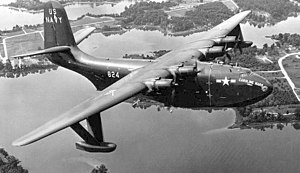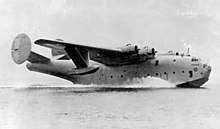Martin JRM
| Martin JRM Mars | |
|---|---|
 The only JRM-2 (Caroline Mars) |
|
| Type: | Transport plane |
| Design country: | |
| Manufacturer: | |
| First flight: |
July 3, 1942 |
| Commissioning: |
1945 |
| Production time: |
1945 to 1947 |
| Number of pieces: |
7th |
The Martin JRM Mars was the largest flying boat ever mass-produced . The prefix "JR" was used by the US Navy from 1935 to 1955 for use as a "utility transport". The Mars was developed from 1938 by the American Glenn L. Martin Company for the US Navy .
history
Patrol bombers
The US Navy ordered a prototype for a large patrol bomber from Martin in August 1938 . The company had years of experience in building bombers and flying boats and derived the design (Model 170) from their PBM Mariner . On August 20, 1941, the keel was laid near Baltimore , Maryland ; The model, designated by the Navy as XPB2M-1 and called Old Lady , was launched on November 5, 1941. The machine was given the BuNo 1520. During tests in Chesapeake Bay on December 5, 1941, a propeller blade on one of the four came off Wright R-3350-8 engines. A subsequent fire damaged the prototype so badly that further development was delayed by more than half a year. The first flight finally took place on July 3, 1942.
Transport plane
In the meantime, the US Navy had changed its requirements: attacks at sea should increasingly be carried out by carrier-supported aircraft and instead the flying boat should transport supplies and troops to relieve ships that were increasingly being attacked by German submarines . So Martin removed the mounts for bombs and on-board weapons and converted the prototype into the XPB2M-1R . From November 1943 to March 1945, the Old Lady carried up to 15.8 tons of cargo across the seas for the Navy, after which the machine was returned to Martin for testing and training purposes. Until the long-range bomber Convair B-36 was commissioned in 1947, it remained the largest aircraft in the US armed forces.
In January 1945 the US Navy ordered 20 machines under the new designation JRM-1 (Model 170A). For this production model, Martin lengthened the fuselage by around 1.8 meters and replaced the double vertical stabilizer on the previous model with a single one. The maximum takeoff weight increased to 67.4 tons.
The first JRM-1 was named Hawaii Mars (BuNo 76819) on July 21, 1945 , but crashed on August 5 in a crash landing. After Japan surrendered ten days later, the US Navy reduced its order to six machines, four of which Martin delivered by mid-1946. In the name of the name, Martin followed up on the Martin M-130, which had been successful ten years earlier . The four remaining JRM-1 were also named after Pacific island groups, the most frequent destinations of the flying boats: Philippine Mars (76820), Marianas Mars (76821), Marshall Mars (76822) and the second Hawaii Mars (76823). All flying boats were assigned to Navy Squadron VR-2.
In July 1947, Martin completed the seventh and last Mars with new, 3000 hp engines from Pratt & Whitney (R-4360-4T Wasp Major) and the changed designation JRM-2 (Model 170B). She was christened Caroline Mars (76824). This machine set a new record on September 5, 1948 with 31 tons of cargo on the flight from Chesapeake Bay to Cleveland , Ohio , as did the Marshall Mars on March 4, 1949 with 263 passengers.
By 1950, the Navy had the three still existing JRM-1s upgraded to the JRM-2 level and also equipped them with R-4360-4 engines. The new name for these machines was JRM-3 (Model 170B). The Marshall Mars was destroyed on April 5, 1950 in an emergency landing off Hawaii after an engine failure.
Fire-fighting aircraft
In 1956, the Navy transport squadron VR-2 began to retire the Mars and replace it with Convair R3Y . The last flight of a Mars took place in August 1956; then the machines were put ashore in Alameda (California) . Three years later, the planes were sold to a scrapping company for a total of $ 23,650. At the instigation of a Canadian pilot, who saw the four machines as very suitable platforms for fighting forest fires, a British Columbia consortium of timber companies bought the JRM in 1959 and registered it as Forest Industries Flying Tankers (FIFT). In addition to the aircraft, FIFT also purchased all spare parts, including 35 R-3350-24WA engines that were still in existence. In the long term, retrofitting was seen as the most economical solution, despite the payload reduction of 4500 kg, as the maintenance of the original R-4360-4 engines was considered to be much more expensive. After they were restored to an airworthy condition, the aircraft were transferred to the Fairey Aviation of Canada in Victoria for conversion into fire-fighting aircraft , where the engines were also replaced. With the fire extinguishing equipment, an aircraft can take up to 27,216 liters of extinguishing water at about 130 km / h just above the water surface ("on the step ") within 25 seconds and drop it from a height of 50 meters over an area of 1.6 hectares.
In June 1961, the Marianas Mars was lost in an accident, all four crew members were killed, a year later the Caroline Mars was destroyed on the ground in a winter storm. In 2007, Flying Tankers was taken over by Coulson Aircrane Limited . The Philippine Mars was shut down for a long time . In August 2012 it was announced that it would not return to active operation, but would be handed over to the National Museum of Naval Aviation in Pensacola , Florida. The machine was given its original Navy livery again, but remained with Coulson Flying Tankers for reasons unknown.
On August 4, 2012, a group of people climbing the Hawaii Mars caused damage to the tail unit. This was not discovered during the preflight check on August 5th before a fire attack. Since the mission was canceled, the plane turned around and landed again. After that, the damage that could have caused a crash was noticed. The repair was carried out the same day to restore operational readiness.
The Hawaii Mars was the last aircraft to be regularly used as a fire-fighting aircraft until autumn 2013 ; it is stationed on Sproat Lake in British Columbia , Canada . Their use cost about 5000 US dollars per flight hour, on average one flight hour caused around five hours of maintenance - also due to the fact that the radial engines have not been manufactured for a long time. There were only twelve engines left for the two remaining aircraft, so they were replaced at two-week intervals to ensure that all engines were evenly worn. According to the website of Coulson Aircrane Ltd. Both the Philippine Mars (registered in the Canadian Civil Aircraft Register under C-FLYK ) and the Hawaii Mars (registered under C-FLYL ) are still available as fire fighting aircraft.
In the 2015 forest fire season, the Hawaii Mars was again used as a fire fighting aircraft. The British Columbia Department of Forestry had signed a one-month contract with the Coulson Group. In addition, it was chartered to the “International Test Pilot School” in August 2015. Chinese pilots and engineers used it to practice handling large seaplanes in preparation for flight tests of the Avic AG600 .
Production overview
| BuNo | variant | Surname | Whereabouts | last use |
|---|---|---|---|---|
| 1520 | XPB2M-1, XPB2M-1R | Test aircraft | ||
| 76819 | JRM-1 | Hawaii Mars | August 5, 1945 Accident in Chesapeake Bay, recovered but not made airworthy |
Transport plane |
| 76820 | JRM-1, then JRM-3 | Philippine Mars | Fire-fighting aircraft | |
| 76821 | JRM-1, then JRM-3 | Mariana's Mars | Lost June 1961 | Fire-fighting aircraft |
| 76822 | JRM-1 | Marshall Mars | Destroyed April 5, 1950 | Transport plane |
| 76823 | JRM-1, then JRM-3 | second Hawaii Mars | Fire-fighting aircraft | |
| 76824 | JRM-2 | Caroline Mars | Lost in Hurricane in 1962 | Fire-fighting aircraft |
Technical specifications
| Parameter | Data from the Martin JRM-2 Mars |
|---|---|
| length | 35.7 m |
| span | 61.0 m |
| height | 11.7 m |
| Wing area | 342.4 m² |
| Elongation | 10.86 |
| Wing loading | 129.3 kg / m² (10 t payload) - 218 kg / m² (40 t payload) |
| Empty mass | 34.3 t |
| Max. Takeoff mass | 74.8 t |
| Top speed | 350 km / h |
| Max. Altitude | 4450 m |
| Range | 8000 km |
| Engines | four four-row air-cooled radial engines Pratt & Whitney R-4360-4T-Wasp-Major |
| power | 4 × 2240 kW (3,050 hp) |
| Power load | 6.14 kg / PS (full load) |
| crew | 4th |
Web links
literature
- Bill Gunston: The Mighty Mars . In: Airplane Monthly April 1976, pp. 172-177
- Clifford Schwindt: Mars - Bringer of water . In: Airplane Monthly April 1994, pp. 35-38
- Robert F. Dorr: Martin Flying Boats - Variant Briefing . In: Wings of Fame, Vol. 7, 1997, pp. 114-133
- ER Johnson: American Flying Boats and Amphibious Aircraft , McFarland and Co., 2009, ISBN 978-0-7864-3974-4 , pp. 254-258
Individual evidence
- ↑ Explanation on water absorption (last paragraph) , accessed on November 12, 2019
- ↑ a b Coulson Flying Tankers website , accessed November 12, 2019
- ^ Coulson Flying Tankers ( Memento from December 23, 2011 in the Internet Archive )
- ↑ After 50 years battling blazes, waterbomber retires to US timescolonist.com, August 22, 2012, archived from the original on August 25, 2012 ; accessed on October 14, 2012 (English).
- ↑ Waterbomber vandalized: Coulson offers $ 5,000 reward. albernivalleynews, August 7, 2012, archived from the original on January 29, 2013 ; accessed on October 14, 2012 (English).
- ↑ Martin Mars water bomber grounded after 53 years in BC timescolonist.com, September 13, 2013, accessed on February 18, 2014 .
- ^ Canadian Civil Aircraft Register. Transport Canada , accessed on October 13, 2016 (in English, enter the name of the company in the search mask under “Owners Name”).
- ^ Aircraft Fleet • The Mighty Martin Mars. Coulson Aircrane Ltd, accessed July 22, 2015 .
- ↑ Martin Mars water bomber dropped nine loads on fire near Nelson, BC www.theprovince.com, July 20, 2015, archived from the original on July 22, 2015 ; accessed on July 22, 2015 (English).
- ↑ Martin One-month deal revives Martin Mars water bomber. www.timescolonist.com, July 8, 2015, accessed July 22, 2015 .
- ^ Test pilot school a success for Martin Mars. www.albernivalleynews.com, August 6, 2015, archived from the original on March 4, 2016 ; accessed on October 13, 2016 .



